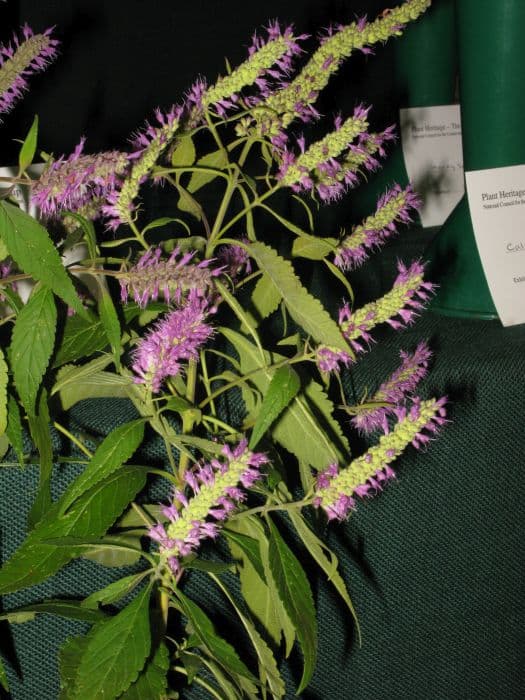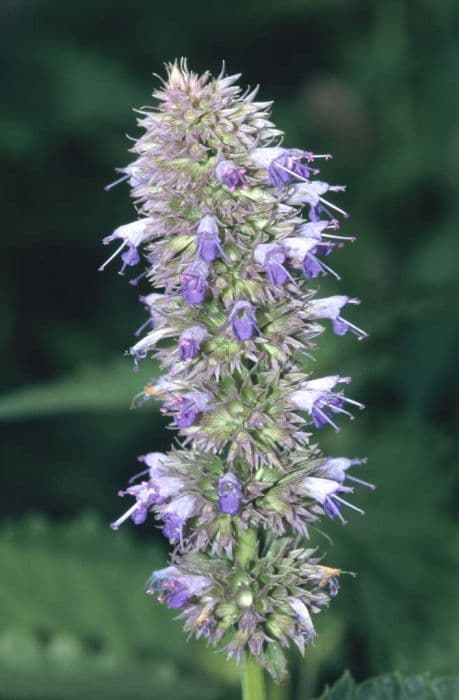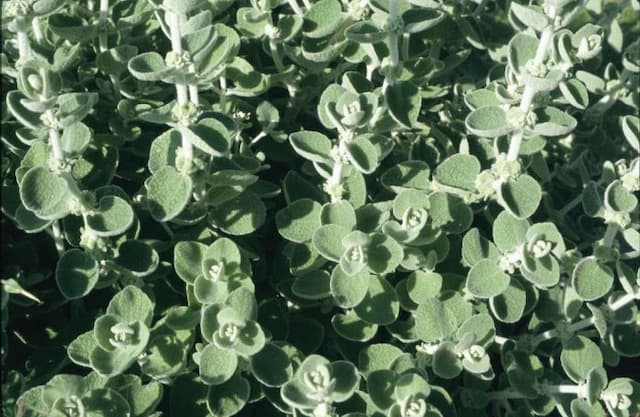Mint Shrub Elsholtzia stauntonii

ABOUT
The common name for Elsholtzia stauntonii is the mint shrub. This plant is known for its aromatic foliage, which resembles that of other mint family members. The leaves of the mint shrub are usually a bright green color, with a slim, lance-shaped profile, and a somewhat serrated edge which gives them a textured feel. During the blooming period, the mint shrub produces clusters of flowers. These blooms typically appear in a tubular shape with a lipped arrangement, reminiscent of many other mint relatives. The flowers are usually a vibrant shade, often purplish or pinkish, which adds a splash of color to the foliage backdrop. The floral clusters can make the plant look quite dense and lush when in full bloom. The general form of the mint shrub is upright and bushy. Its stems are often numerous and well-branched, giving the plant a full and rounded appearance. When the plant is not in bloom, its greenery still ensures that it remains an attractive feature in the landscape due to the dense leaf coverage. The leaves and flowers together emit a pleasant fragrance, which is especially noticeable when the foliage is disturbed or during warm days, adding a sensory appeal to its surroundings. Overall, the mint shrub is an attractive plant that combines both visual charm with aromatic qualities, often favored in gardens for its colorful and fragrant presence.
About this plant
 Names
NamesFamily
Lamiaceae.
Synonyms
Mint Shrub, Chinese Mint Shrub, Elsholtzia.
Common names
Elsholtzia willmottiae, Elsholtzia oldhamii, Elsholtzia formosana.
 Toxicity
ToxicityTo humans
Mint Shrub (Elsholtzia stauntonii) is not widely known to be toxic to humans. However, as with any plant, individual allergies and reactions can occur. If a person has a sensitivity to Mint Shrub, ingesting it could potentially cause mild gastrointestinal upset or an allergic reaction. It is always prudent to use caution and consult with a healthcare provider before ingesting any plant material for which the edibility and safety are not well established.
To pets
Mint Shrub (Elsholtzia stauntonii) is not widely recognized as a toxic plant to pets. However, individual animals can sometimes display sensitivity or allergic reactions to plants that are not generally considered poisonous. If a pet ingests Mint Shrub, they could potentially experience mild gastrointestinal upset. It is generally wise for pet owners to prevent pets from consuming plants that are not known to be safe and to consult with a veterinarian if accidental ingestion occurs and the pet shows signs of distress.
 Characteristics
CharacteristicsLife cycle
Perennials
Foliage type
Deciduous
Color of leaves
Green
Flower color
Lavender
Height
2-3 feet [0.6-0.9 meters]
Spread
2 feet [0.6 meters]
Plant type
Shrub
Hardiness zones
5
Native area
China
Benefits
 General Benefits
General Benefits- Ornamental Value: Elsholtzia stauntonii, commonly known as mint shrub, is valued for its aesthetic appeal in gardens and landscapes due to its vibrant flowers and pleasant foliage.
- Habitat for Wildlife: The mint shrub provides nectar for pollinators such as bees and butterflies, supporting biodiversity.
- Aromatic Qualities: Mint shrub has fragrant leaves and flowers that can create a pleasant scent in outdoor spaces.
- Culinary Uses: The leaves of the mint shrub can be used in cooking for flavoring dishes, similar to other mint family herbs.
- Drought Tolerance: Mint shrub is relatively drought-resistant, making it suitable for xeriscaping and low-water gardens.
- Low Maintenance: Once established, mint shrub typically requires minimal care, making it convenient for gardeners of all skill levels.
 Medical Properties
Medical Properties- Anti-inflammatory: Elsholtzia stauntonii has been used in traditional medicine to reduce inflammation.
- Antibacterial: Extracts from this plant have demonstrated antibacterial properties, potentially useful in combating certain bacterial strains.
- Antioxidant: The plant contains compounds that exhibit antioxidant effects, which may help in the prevention of oxidative stress-related diseases.
- Antidiabetic: Some studies suggest that Elsholtzia stauntonii may have potential in managing blood sugar levels.
- Cold and flu remedy: Historically used in herbal medicine to help alleviate symptoms associated with colds and the flu.
- Gastroprotective: The plant may offer protective benefits for gastrointestinal health.
 Air-purifying Qualities
Air-purifying QualitiesThis plant is not specifically known for air purifying qualities.
 Other Uses
Other Uses- Elsholtzia stauntonii, commonly known as mint shrub, can be used to make natural dyes for coloring textiles, leveraging its pigments to tint fabrics in shades of yellow or brown.
- The foliage of the mint shrub can be composted to create organic matter that enriches the soil, benefiting garden plantings by improving soil structure and fertility.
- Dry leaves of mint shrub can serve as a flavorful addition to potpourris, providing a unique smell that can freshen up living spaces.
- Essential oils extracted from the plant can be used in perfumery to add a distinct aroma to cosmetic products, such as lotions and soaps.
- Mint shrub branches make attractive decor elements, particularly when they are flowering, and can be used in floral arrangements or as a fresh bouquet.
- The plant is suitable for bonsai cultivation, where it can be trained and shaped over years to create miniature artistic representations of trees in nature.
- Its leaves can be dried and incorporated into sachets that deter moths and other insects from wardrobes and linen drawers.
- Due to its hardy nature, mint shrub can be utilized in erosion control, helping to stabilize soil on slopes or in areas prone to erosion.
- The seeds of mint shrub can be used in bird feed mixtures to attract and nourish a variety of avian species in a garden setting.
- Culinary creativity can utilize the herb-like qualities of mint shrub in flavoring homemade syrups or infusions for beverages, though this is less common and should be done with care regarding plant identification and safety.
Interesting Facts
 Feng Shui
Feng ShuiThe Mint Shrub is not used in Feng Shui practice.
 Zodiac Sign Compitability
Zodiac Sign CompitabilityThe Mint Shrub is not used in astrology practice.
 Plant Symbolism
Plant Symbolism- Healing: Elsholtzia stauntonii, commonly known as the Chinese mint shrub, is traditionally used in herbal medicine, symbolizing healing and therapeutic properties.
- Aroma: With its fragrant leaves that release a pleasant scent when bruised, the Chinese mint shrub symbolizes aromatic and sensory pleasure.
- Protection: Plants from the mint family are often associated with protection, and the Chinese mint shrub carries this symbolism, with its strong scent believed to ward off negative energies and pests.
- Resilience: Being a hardy plant that can thrive in various conditions, the Chinese mint shrub stands for resilience and adaptability.
- Purification: The aromatic nature of the Chinese mint shrub lends it to symbolize purification of the air and the environment.
 Water
WaterMint Shrub, or Elsholtzia stauntonii, prefers consistently moist soil but does not like to be waterlogged. During the growing season, water the Mint Shrub deeply when the top inch of soil feels dry, which may be once a week, depending on climate conditions. Reduce watering in the winter when the plant is dormant. Generally, watering with about one to two gallons every week to ten days during the active growth period is sufficient, but always adjust based on rainfall and temperature, as these factors influence soil moisture.
 Light
LightThe Mint Shrub thrives in full sun to partial shade conditions. The best spot for this plant would be an area where it receives at least four to six hours of direct sunlight each day. However, in hotter regions, some afternoon shade is beneficial to prevent scorching of the leaves. Avoid deep shade as this can result in a leggy plant with fewer blooms.
 Temperature
TemperatureThe Mint Shrub is tolerant of a wide range of temperatures but performs best in zones with temperatures ranging between 60°F and 75°F. It can survive minimum temperatures down to around 10°F and maximum temperatures well into the high 80s or low 90s Fahrenheit. The ideal conditions are moderate temperatures with protection from extreme cold and heat.
 Pruning
PruningPruning the Mint Shrub is essential to promote healthy growth and abundant flowering. Prune in late winter or early spring before new growth begins. Remove any dead or damaged branches and shape the plant as needed. Periodic thinning of the branches allows light and air to circulate better, encouraging stronger stems and blooms. It's often enough to prune once a year, but some light maintenance may be needed throughout the growing season to remove any spent flowers or irregular growth.
 Cleaning
CleaningAs needed
 Soil
SoilMint Shrub thrives in well-drained, fertile loam with a pH range of 6.0 to 7.5. A good mix would consist of two parts garden soil, one part sand, and one part compost to ensure proper drainage and fertility.
 Repotting
RepottingMint Shrub should generally be repotted every two to three years or when the root system outgrows the current pot, to ensure continued growth and health.
 Humidity & Misting
Humidity & MistingMint Shrub prefers moderate to high humidity levels but is adaptable to average household humidity. Ensure good air circulation to prevent disease.
 Suitable locations
Suitable locationsIndoor
Place Mint Shrub in bright, indirect light and maintain moderate humidity.
Outdoor
Plant Mint Shrub in partial shade and well-draining soil.
Hardiness zone
5-9 USDA
 Life cycle
Life cycleElsholtzia stauntonii, commonly known as mint shrub, begins its life cycle as a seed, which, once dispersed, requires suitable soil and environmental conditions to germinate. Upon germination, the seedling emerges and develops into a juvenile plant with initial foliage growth, followed by the development of a branching system as it matures into an adult plant. In the adult stage, mint shrub produces abundant flowers, generally in late summer to fall, which are pollinated by various insects. After pollination, flowers develop into seed capsules that eventually release seeds when mature, thus completing the reproductive cycle. The plant is a perennial herb, and after flowering, it undergoes a period of dormancy in winter, only to resprout from the rhizome in spring, ready for the next growth cycle. This cyclical pattern of growth, reproduction, dormancy, and regrowth continues annually throughout the plant's lifespan.
 Propogation
PropogationPropogation time
Spring-summer
For mint bush, or Elsholtzia stauntonii, the most popular method of propagation is by seed. Typically, seeds are sown in the spring after the danger of the last frost has passed. The seeds should be scattered over well-draining soil and thinly covered with a fine layer of soil. The soil should be kept lightly moist until germination, which usually occurs within 2 to 3 weeks. Once the seedlings have developed a couple of true leaves, they can be thinned out or transplanted to their final growing location, ensuring they are spaced about 12 to 18 inches (approximately 30 to 45 centimeters) apart to allow for sufficient room to grow.









